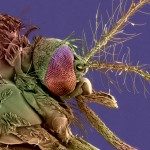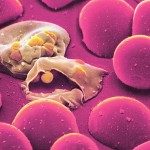Lien vers Pubmed [PMID] – 23167500
Vector Borne Zoonotic Dis. 2012 Dec;12(12):1036-41
Chikungunya virus (CHIKV) is transmitted to humans through the bite of Aedes mosquitoes. During the 2005-2006 epidemic that occurred in the Indian Ocean Islands, a viral strain harboring a substitution of an alanine to valine at position 226 (E1-A226V) of the E1 glycoprotein enhanced the transmissibility of CHIKV by Aedes albopictus. In March 2011, autochthonous transmission of CHIKV was reported in New Caledonia (NC), an island located in the southwest Pacific Ocean. This was the first report of local chikungunya (CHIK) transmission in this region of the world. Phylogenetic analysis based on the complete genome demonstrated that the CHIKV-NC strain isolated from the first autochthonous human case belongs to the Asian lineage. This is consistent with the Indonesian origin of CHIK cases previously imported and detected. Thus the CHIKV-NC does not present a valine substitution at position E1-226. In New Caledonia, the putative vector of CHIKV is Aedes aegypti, since no other potential vector has ever been described. For example, A. albopictus is not found in NC. Vector competence experiments showed that A. aegypti from New Caledonia was able to transmit, as early as 3 days post-infection, two CHIKV strains: CHIKV-NC belonging to the Asian lineage, and CHIKV-RE from Reunion Island harboring the E1-A226V mutation. Thus the extrinsic incubation period of both CHIKV strains in this vector species could be considered to be quite short. These results illustrate the threat of the spread of CHIKV in the South Pacific region. From February to June 2011 (the end of the alert), only 33 cases were detected. Implementation of drastic vector control measures and the occurrence of the cold season probably helped to limit the extent of the outbreak, but other factors may have also been involved and are discussed.




